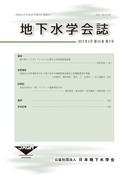All issues

Volume 49 (2007)
- Issue 4 Pages 291-
- Issue 3 Pages 191-
- Issue 2 Pages 97-
- Issue 1 Pages 3-
Volume 49, Issue 2
Displaying 1-4 of 4 articles from this issue
- |<
- <
- 1
- >
- >|
-
Seongwon LEE, Norio TASE2007 Volume 49 Issue 2 Pages 97-114
Published: May 31, 2007
Released on J-STAGE: December 11, 2012
JOURNAL FREE ACCESSBiochemical remediation methods are effective measures for the nitrate contaminated groundwater. The aims of this study are to understand the biochemical remediation process of nitrate from contaminated groundwater and to explain a suitable treatment: The permeable treatment barrier under oxidative condition. The experiment was conducted in Tsukuba Upland, Japan, where the denitrification process was not possible to expect. After four months from the startup of the experiment, the nitrate concentration decreased from 37.5 mg/L (upstream observation wall) to 0.1 mg/L inside the permeable treatment barrier. Until recently, condition of the denitrification reaction was thought that it is the abundant organic matter and restore environment. But, from the result of this study, it is notified that high abundance of organic matter creates a reductive environment which depends directly on the metabolism of microorganisms that are responsible for decomposition of organic matter. So, we can conclude that the most important limiting factor of the denitrification reaction is the abundance of the organic matter as a electron donor.View full abstractDownload PDF (10680K) -
Naoto TAKAHASHI, Hiromi SEGAWA, Kazue TAZAKI2007 Volume 49 Issue 2 Pages 115-137
Published: May 31, 2007
Released on J-STAGE: December 11, 2012
JOURNAL FREE ACCESSAt several landslide areas in Niigata pre f ecture, the reddish-brown microbial mats formed in drainpipes and water catchments well for a short period such as within three years after the construction. In this study, the damage situation in such an institution by microbial mats formed by iron bacteria, and examined growth environment of iron bacteria on drainpipes at landslide areas in Niigata prefecture. The microbial mats were formed by iron bacteria, such as Toxothrix trichogenes and Leptothrix ocheracea.
The microbial mats were more remarkable in areas mainly containing clays than sandstone areas. The microbial mats were seen in the aquatic environment where the oxidation-reduction potential (Eh) was in the range of + 165 to + 244 mV and the concentration of dissolved oxygen (DO) was in the range of 2.7 to 7.4 mg/L. In addition, more microbial mats were formed around the part in the range of about 0 to 15 meters from the aperture mouth of drainpipes, while less microbial mats were formed in the deep part of drainpipes. The formation of microbial mats was remarkable under the condition where the reductive groundwater was exposed to the atmosphere and suddenly changed into an oxidation state. The formation of microbial mats changes groundwater quality itself.
High pressure wa ter is the only way to wash off the microbial mats at this moment. However, the microbial mats are formed completely within several months to one year at Ohirota landslide area in Niigata prefecture.View full abstractDownload PDF (50618K) -
Takashi MIZUNO, Richard METCALFE, Teruki IWATSUKI, Hideki MIE2007 Volume 49 Issue 2 Pages 139-152
Published: May 31, 2007
Released on J-STAGE: December 11, 2012
JOURNAL FREE ACCESSHydrochemical studies are generally condu cted based on chemical data of groundwater samples. Various methodologies exist for obtaining samples and for assessing the quality of the collected sample. This study is aimed at establishing a methodology for quality assessment of chemical data obtained from groundwater samples using a method known as Evidence Support Logic. In this study, pH data of groundwater obtained from several boreholes were assessed using this method. The results showed that 23 out of 63 samples satisfied the applied quality criteria. When plotted, the data from the 23 samples show a constant value from top to bottom of investigation area when compared to a plot using data from all samples. These results indicate that the quality assessment method demonstrated by this study is applicable to groundwater studies and that by considering the sample quality it will be possible to develop a clearer interpretation of the deep underground geochemical environment.View full abstractDownload PDF (9636K) -
Shiho YABUSAKI, Norio TASE, Maki TSUJIMURA, Yousay HAYASHI2007 Volume 49 Issue 2 Pages 153-168
Published: May 31, 2007
Released on J-STAGE: December 11, 2012
JOURNAL FREE ACCESSDownload PDF (36827K)
- |<
- <
- 1
- >
- >|